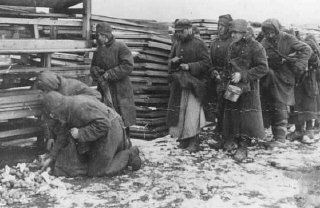|
|

|

|
Soviet prisoners of war pause for rations during forced labor at the narrow-gauge railroad station. Mlawa, Poland, about 1943. See more photographs |
FORCED LABOR: SOVIET POWS JANUARY 1942 THROUGH MAY 1945 |
||||
|
|
Hitler expected a quick campaign against the Soviet Union. In this regard he and his military planners were caught in their own ethnic and racial stereotypes. They thought of Slavs as stupid and incompetent and believed that the Communist Soviet Union was in the grip of Jews, whom they regarded as cowardly and perfidious. Such attitudes caused the German leaders to make some severe miscalculations. Initial German military successes were indeed impressive; German units reached the outskirts of Moscow in early December 1941. Hitler and his generals had anticipated quick victory, another lightning war ending with German victory. But the German invasion did not turn out as planned and the German army was exhausted after months of campaigning. The Soviets were better equipped than the German planners thought and the Germans themselves were overextended and had not thought it necessary to prepare the army for winter. Moreover, the speedy German advance had caused the forces to outrun their supply lines, which were vulnerable due to the great distances involved (Moscow is almost 1,000 miles east of Berlin). In December 1941, the Soviet Union launched a major counterattack against the center of the front, driving the Germans back from Moscow in chaos. Only weeks later were the Germans able to stabilize the front east of Smolensk, but it was clear to everybody, even Hitler, that the war would last much longer than they had anticipated. |
|
In January 1942, Hitler authorized better treatment of Soviet prisoners of war (POWs) because the war had bogged down and German authorities decided Soviet POWs were a useful source of wartime labor. The labor shortage in the German war economy was reaching critical proportions. They provided Soviet POWs with slightly better rations -- though they were still far short of the rations allotted to other POWs and to the German civilian population. As a result, the enormous death rate among the Soviet POWs was contained, but until the end of the war it was still much higher than that among the other POWs. In 1943 and 1944, however, the death rates soared again due to starvation and disease. Soviet POWs were involved in heavy labor: building roads, in coal mining, agriculture, and construction. The change in policy towards soviet POWs underscores the commitment of the Nazi regime to the killing of Jews. Despite the severe labor shortage, the SS killed millions of Jews in occupied Poland during 1942. After the war, the suffering of Soviet POWs who survived German captivity did not end. While they were liberated from Nazi camps, Soviet authorities often accused its POWs of collaboration with the Nazis. After their repatriation, many of them faced interrogation and trial before Soviet authorities. In most cases they were convicted of collaboration and sentenced to confinement in a Soviet forced-labor camp. Most of them remained there until after the death of Josef Stalin in 1953. |
|
|
|